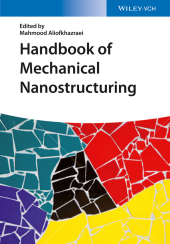 Neuerscheinungen 2015Stand: 2020-02-01 |
Schnellsuche
ISBN/Stichwort/Autor
|
Herderstraße 10
10625 Berlin
Tel.: 030 315 714 16
Fax 030 315 714 14
info@buchspektrum.de |

Mahmood Aliofkhazraei
Handbook of Mechanical Nanostructuring, 2 Vols.
Herausgegeben von Aliofkhazraei, Mahmood
1. Auflage. 2015. LX, 756 S. 200 SW-Abb., 25 Farbabb. 244 mm
Verlag/Jahr: WILEY-VCH 2015
ISBN: 3-527-33506-4 (3527335064)
Neue ISBN: 978-3-527-33506-0 (9783527335060)
Preis und Lieferzeit: Bitte klicken
BOTTOM-UP SYNTHESIS AND PROCESSING OF NANOSTRUCTURES
Mechanical Alloying
Chemical Vapor Deposition
Rapid Solidification
TOP-DOWN SYNTHESIS AND PROCESSING OF NANOSTRUCTURES: SEVERE PLASTIC DEFORMATION
High Pressure Torsion
Equal Channel Angular Pressing
Cyclic Extrusion Compression
Accumulative Roll Bonding
Surface Mechanical Attrition
PROPERTIES OF MECHANICALLY SYNTHESIZED NANOSTRUCTURED MATERIALS
Strength in Ambient Temperatures
Superplasticity
Corrosion Resistance
Grain Structure
FUTURE DIRECTIONS OF MECHANICAL NANOSTRUCTURING
Repetitive Corrugation and Strengthening
Cyclic Closed-Die Forging
APPLICATIONS
Direct Synthesis of Metallic Workpieces
Ductility Improvement
Grain Boundary Engineering
Biomedical Applications
Providing in-depth information on how to obtain high-performance materials by controlling their nanostructures, this ready reference covers both the bottom-up and the top-down approaches to the synthesis and processing of nanostructured materials.
The focus is on advanced methods of mechanical nanostructuring such as severe plastic deformation, including high pressure torsion, equal channel angular processing, cyclic extrusion compression, accumulative roll bonding, and surface mechanical attrition treatment. As such, the contents are inherently application-oriented, with the methods presented able to be easily integrated into existing production processes. In addition, the structure-property relationships and ways of influencing the nanostructure in order to exhibit a desired functionality are reviewed in detail. The whole is rounded off by a look at future directions, followed by an overview of applications in various fields of structural and mechanical engineering.
With its solutions for successful processing of complex-shaped workpieces and large-scale specimens with desired properties, this is an indispensable tool for purposeful materials design.
Dr. Mahmood Aliofkhazraei is a researcher in the corrosion and surface engineering group at the Tarbiat Modares University. Dr. Aliofkhazraei has received several honors, including the Khwarizmi award and the best young nanotechnologist award of his country. He is a member of the National Association of Surface Sciences, Iranian Corrosion Association, and National Elite Foundation of Iran. His research focuses on nanotechnology and its use in surface and corrosion science.


